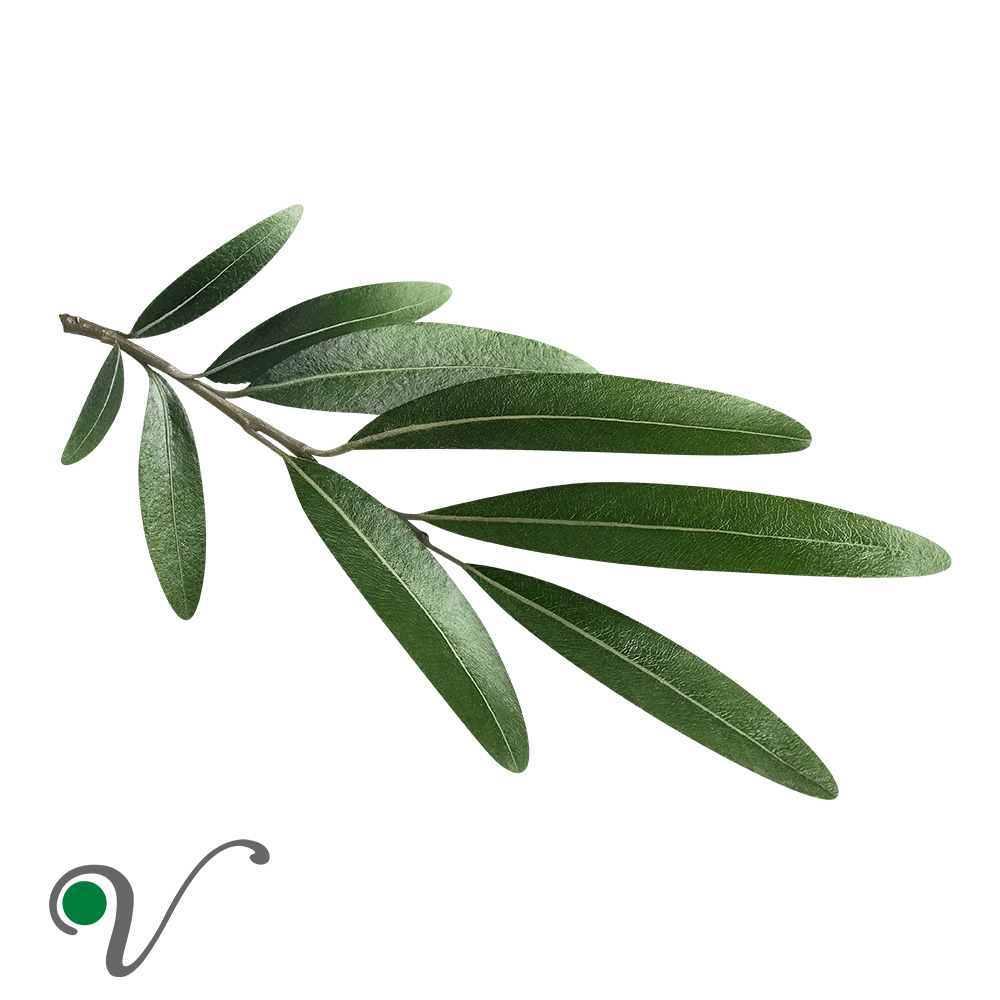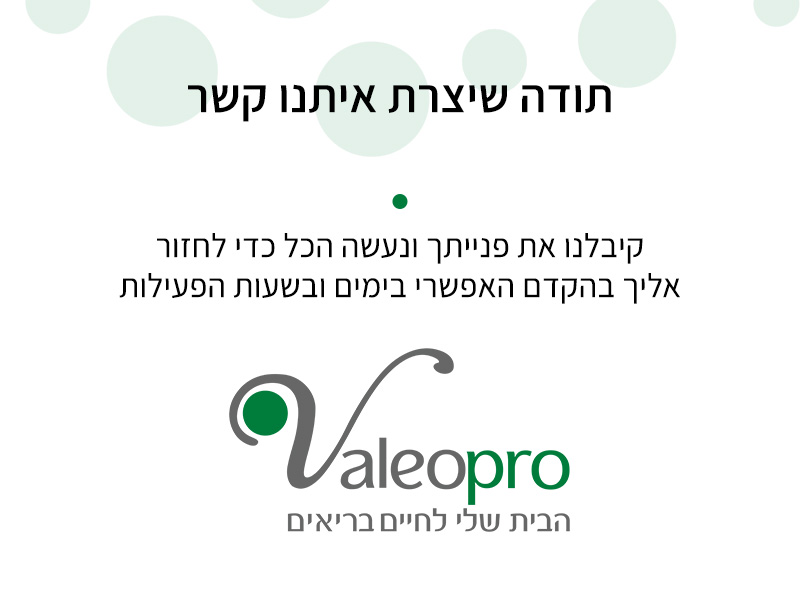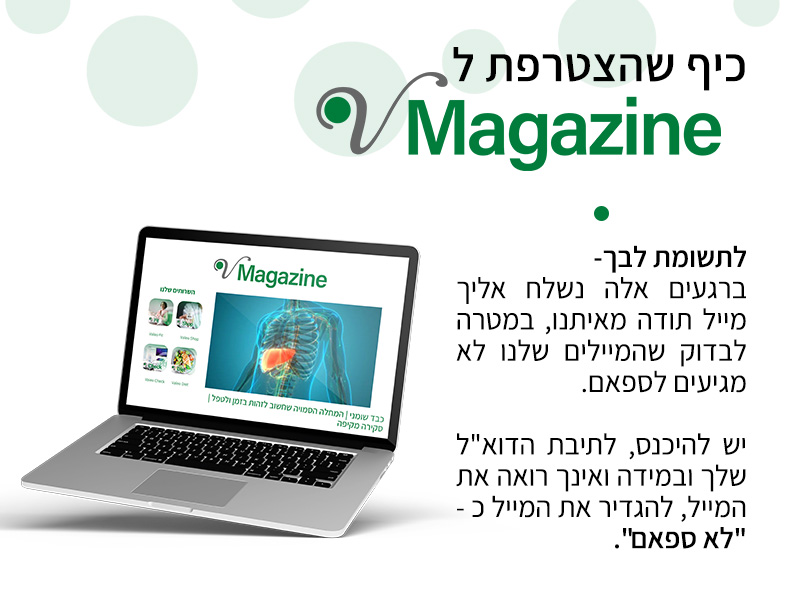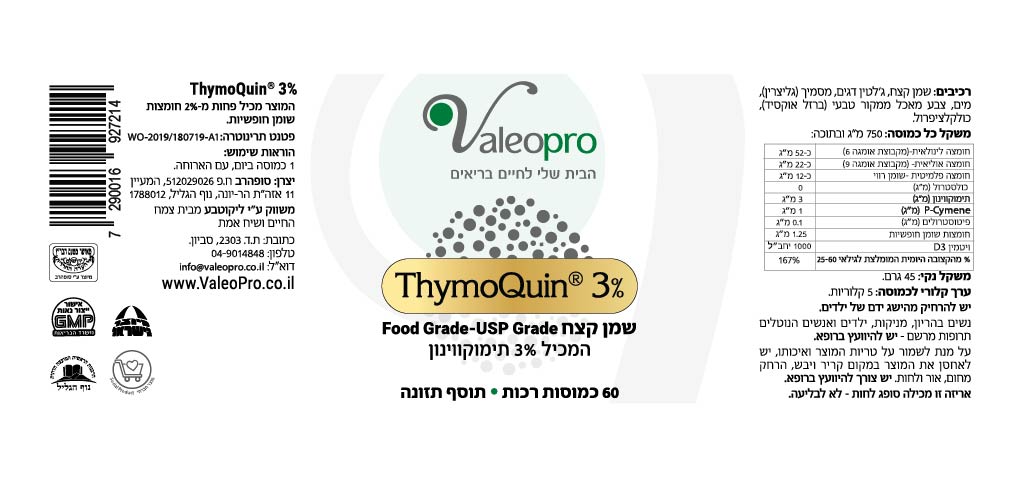משלוח מהיר חינם | שיחת ייעוץ נטורופתי ללא עלות
עץ הזית הוא אחד מהצמחים העתיקים ביותר בהיסטוריה ושימושיו לבני האדם רבים מאוד. יכולת ההישרדות של עץ הזית גדולה מאוד גם בתנאים קשים של אקלים. יכולת ההישרדות הזו קשורה לרכיבים פעילים הקיימים בעץ שבזכותם העץ וחלקיו גם ידועים בסגולות ריפוי. הנודע ביותר מתוצרי עץ הזית הוא השמן המופק מהפירות- הזיתים, אך גם לעלי הזית מלבד סמל השלום יש תפקיד חשוב ברפואה המסורתית וגם אלפי מחקרים קליניים המצביעים על תועלות ייחודיות.
הרכיבים הפעילים העיקריים בעלי הזית:
מונוטרפנים אירידואידים (6-9% סך-הכל, בעיקר oleuropein ונגזרותיו), פוליפנוֹלים (גליקוזידים של הפלבונואידים luteolin ו-apigenin), טריטרפנים (oleanolic acid, maslinic acid), פלבונואידים (rutin).
עלי הזית מכילים חומרים פעילים כגון פלבונואידים, פוליפנולים, סקוויטרפן וסטרולים, אשר ידועים ביכולתם לסייע בפעילות נוגדי החמצון בגוף ולהפחית תהליכים דלקתיים. למעשה, האנטי-דלקת הטבעית של עלי הזית מקנה להם יתרונות בריאותיים רבים, כולל תמיכה במערכת הלב והעור, שיפור פעילות החיסון, הפחתת סיכונים למחלות ממטרופולית כמו סוכרת ומחלות לב, ועזרה בהפחתת כולסטרול וטריגליצרידים בדם.
פעילות רפואית מוכחת מחקרית:
בנוסף, עלי הזית ידועים גם ביכולתם לסייע בתמיכה במערכת העיכול והפגת הגזים, להשפעה נוגדת חמצון על כלי הדם ולתמיכה בתפקוד הכבד.
1/ Cruess WV, and Alsberg CL, The bitter glucoside of the olive. J. Amer.
Chem. Soc. 1934; 56:2115-7.
3/ Panizzi L et al, The constitution of oleuropein, a bitter glucoside of the
olive with hypotensive action. Gazz. Chim. Ital; 1960; 90:1449-85.
Petkov V and Manolov P, Pharmacological analysis of the iridoid
oleuropein. Drug Res., 1972; 22(9); 1476-86.
4/ Juven B et al, Studies on the mechanism of the antimicrobial action of
oleuropein. J. Appl. Bact., 1972; 35:559-67.
5/ Kubo I et al, A mutichemical defense mechanism of bitter olive olea
europaea (Oleaceae)– Is oleuropein a phytoalexin precursor? J. Chem. Ecol
1985; 11(2):251-63.
2. מחקר שפורסם בשנת 2017 במגזין "Molecules" בדן את השפעת תמצית עלי זית על לחץ הדם. המחקר בדק את השפעת צריכת תמצית עלי זית על לחץ הדם במודלים בעלי מעטפת אנושית. המחקר מצא כי תמצית עלי זית עשויה להוריד את רמות לחץ הדם.
21/ Samuelsson G, The blood pressure lowering factor in leaves of Olea
Europaea. Farmacevtisk Revy, 1951; 15: 229-39
Veer WLC et al, A compound isolated from olea europaea. Recueil, 1957;
76:839-40
6. מחקר שפורסם בשנת 2015 במגזין "Phytomedicine" בדן את השפעת תמצית עלי זית על לחץ הדם וארבע הפרמטרים הקרדיו-מטבוליים השונים. המחקר בדק את השפעת צריכת תמצית עלי זית על מדדים שונים כמו לחץ דם, כולסטרול, גלוקוז וטריגליצרידים בקבוצת משתתפים במחקר. המחקר מצא כי תמצית עלי זית עשויה לשפר את מדדי הלחץ דם והפרמטרים הקרדיו-מטבוליים השונים.
7. מחקר שפורסם בשנת 2017 במגזין "Molecules" בדן את השפעת תמצית עלי זית על פרופיל הליפידים בדם. המחקר בדק את השפעת צריכת תמצית עלי זית על רמות הכולסטרול HDL והטריגליצרידים בקבוצת משתתפים. המחקר מצא כי תמצית עלי זית יכולה להפחית את רמות הטריגליצרידים ולשפר את יחס הכולסטרול HDL/כולסטרול כללי.
8. מחקר שפורסם בשנת 2016 במגזין "Journal of Nutrition" בדן את השפעת תמצית עלי זית על פרופיל הליפידים ורמות הכולסטרול HDL בדם. המחקר בדק את השפעת צריכת תמצית עלי זית על רמות הכולסטרול HDL בקבוצת משתתפים. המחקר מצא כי תמצית עלי זית עשויה להגביר את רמות הכולסטרול HDL בדם.
9. מחקר שפורסם בשנת 2019 במגזין "International Journal of Molecular Sciences" בחן את השפעת תמצית עלי זית על רמות הכולסטרול LDL והטריגליצרידים. המחקר בדק את השפעת צריכת תמצית עלי זית על רמות הכולסטרול LDL והטריגליצרידים בקבוצת משתתפים. המחקר מצא כי תמצית עלי זית עשויה להוריד את רמות הכולסטרול LDL והטריגליצרידים בדם.
10. מחקר שפורסם בשנת 2016 במגזין "Phytotherapy Research" בדן את השפעת תמצית עלי זית על פרופיל הליפידים בדם. המחקר בדק את השפעת צריכת תמצית עלי זית על רמות הכולסטרול LDL, כולסטרול HDL והטריגליצרידים בקבוצת משתתפים. המחקר מצא כי תמצית עלי זית יכולה להפחית את רמות הכולסטרול LDL והטריגליצרידים ולשפר את יחס הכולסטרול HDL לכולסטרול כולל.
11. מחקר שפורסם בשנת 2018 במגזין "Current Pharmaceutical Design" ערך סקירה של מחקרים קליניים וניסי שהבחינו בהשפעת תמצית עלי זית על רמות הכולסטרול LDL. הסקירה מצאה כי הצריכה של תמצית עלי זית או שמן זית במזון הובילה להורדה של רמות הכולסטרול LDL בגוף.
12. מחקר שפורסם בשנת 2013 במגזין "Journal of Nutritional Biochemistry" בחן את השפעת תמצית עלי זית על כולסטרול LDL במודלים בעלי מעטפת אנושית. המחקר מצא כי תמצית עלי זית יכולה להפחית את הכולסטרול LDL במערכת העיכול ולסייע בהגברת פעילות החומרים המסיעים את הכולסטרול לאברים אחרים בגוף.
13. מחקר שפורסם בשנת 2019 במגזין "Molecules" בדן את השפעת תמצית עלי זית על פעילות האנזימים המעכלים במערכת העיכול. המחקר בדק את השפעת תמצית עלי זית על פעילות האנזימים המעכלים במערכת העיכול במודלים בעלי מעטפת אנושית. המחקר מצא כי תמצית עלי זית עשויה לתמוך בפעילות האנזימים המעכלים ולשפר את תהליכי העיכול.
14. מחקר שפורסם בשנת 2015 במגזין "Food Chemistry" בדן את השפעת תמצית עלי זית על תפקוד הקיבה. המחקר בדק את השפעת צריכת תמצית עלי זית על תפקוד הקיבה ופעילות הפרוביוטיקה במערכת העיכול. המחקר מצא כי תמצית עלי זית עשויה לשפר את תפקוד הקיבה ולעזור בתחזוקת פלורת המיקרובים החיונית במערכת העיכול.
15. מחקר שפורסם בשנת 2016 במגזין "Frontiers in Nutrition" חקר את השפעת החומרים הפוליפנוליים שבתמצית עלי זית על תגובת החיסון במערכת החיסון. המחקר חקר את השפעת תמצית עלי זית על תגובת המערכת החיסון במודלים בעלי מערכת החיסון. המחקר מצא כי חומרים פוליפנוליים כגון הקטכואל והאולאפולנול הנמצאים בתמצית עלי זית עשויים לשפר תגובת החיסון ולחזק את המערכת החיסונית.
16. מחקר שפורסם בשנת 2011 במגזין "Molecular Nutrition & Food Research" חקר את השפעת תמצית עלי זית על תפקוד המערכת החיסונית. המחקר בדק את השפעת צריכת תמצית עלי זית על התפקוד המונוציטארי והטובוציטארי של המערכת החיסונית בקבוצת משתתפים. המחקר מצא כי תמצית עלי זית עשויה לשפר את תפקוד המערכת החיסונית ולחזק את המנגנונים המונוציטאריים והטובוציטאריים.
17. מחקר שפורסם בשנת 2019 במגזין "Molecules" בדן את השפעת תמצית עלי זית על תגובת החיסון במערכת החיסון. המחקר חקר את השפעת תמצית עלי זית על תגובת המערכת החיסון במודלים בעלי מערכת החיסון. המחקר מצא כי חומרים פוליפנוליים כגון הקטכואל והאולאפולנול הנמצאים בתמצית עלי זית עשויים לשפר תגובת החיסון ולחזק את המערכת החיסונית.
18. מחקר שפורסם בשנת 2011 במגזין "Molecular Nutrition & Food Research" בדן את השפעת תמצית עלי זית על תפקוד המערכת החיסונית. המחקר בדק את השפעת צריכת תמצית עלי זית על תפקוד המערכת החיסונית בקבוצת משתתפים. המחקר מצא כי תמצית עלי זית עשויה לשפר את תפקוד המערכת החיסונית ולחזק את המנגנונים המונוציטאריים והטובוציטאריים.
19. מחקר שפורסם בשנת 2010 במגזין "Molecular Nutrition & Food Research" חקר את השפעת תמצית עלי זית על נוגדי החמצון בגוף ועל תפקוד כלי הדם. המחקר מצא כי תמצית עלי זית היא נוגדת חמצון יעילה המסייעת להגן על תאי כלי הדם מפעילות חמצונית ומסייעת בתמיכה בפונקציה הכלייתית.
20. מחקר שפורסם בשנת 2016 במגזין "Nutrition Research Reviews" בדן את השפעת פוליפנולים בתמצית עלי זית על האינדיקציה הביולוגית של נוגדי חמצון בגוף. המחקר מצא כי פוליפנולים הנמצאים בתמצית עלי זית יכולים להפעיל תפקוד נוגד חמצון ולהגן על כלי הדם מפעילות חמצונית.
מקורות מחקריים נוספים:
Geller-Bernstein C, Arad G, Keynan N, Lahoz C, Cardaba B, Waisel Y. Hypersensitivity to pollen of Olea europaea in Israel. Allergy. 1996 May;51(5):356-9. https://www.researchgate.net/publication/14369737.
Kirmaz C, Yuksel H, Bayrak P, Yilmaz O. Symptoms of the olive pollen allergy: do they really occur only in the pollination season? J Investig Allergol Clin Immunol. 2005;15(2):140-5. https://www.ncbi.nlm.nih.gov/pubmed/16047715.
Florido Lopez JF, Quiralte Enriquez J, Arias de Saavedra Alías JM, Saenz de San Pedro B, Martin Casañez E.An allergen from Olea europaea pollen (Ole e 7) is associated with plant-derived food anaphylaxis. Allergy. 2002;57 Suppl 71:53-9. https://www.ncbi.nlm.nih.gov/pubmed/12173271.
Quiralte J, Florido F, Arias de Saavedra JM, Gómez A, Sáenz de San Pedro B, González E, Rodríguez R. Olive allergen-specific IgE responses in patients with Olea europaea pollinosis. Allergy. 2002;57 Suppl 71:47-52. https://www.ncbi.nlm.nih.gov/pubmed/12173270.
Cherif S, Rahal N, Haouala M, et al. A clinical trial of a titrated Olea extract in the treatment of essential arterial hypertension. J Pharm Belg 1996;51:69-71. [Article in French]. https://www.ncbi.nlm.nih.gov/pubmed/8786521.
Bitler CM, Matt K, Irving M, et al. Olive extract supplement decreases pain and improves daily activities in adults with osteoarthritis and decreases plasma homocysteine in those with rheumatoid arthritis. https://www.sciencedirect.com/science/article/pii/S0271531707001315.
Petkov V, Manolov P. Pharmacological analysis of the iridoid oleuropein. Arzneim Forsch/Drug Research 1972;22:1476–86. https://www.ncbi.nlm.nih.gov/pubmed/4678608.
Thorne Research, Inc. Olive Leaf. Alternative Medicine Review, Volume 14, Number 1, 2009. p 62-66. http://altmedrev.com/archive/.
European Medicines Agency. Community herbal monograph on Olea europaea L., folium. Committee on Herbal Medicinal Products (HMPC), 22 November 2011. Available here. https://www.ema.europa.eu/documents/herbal-monograph/final-european-union-herbal-monograph-olea-europaea-l-folium-first-version_en.pdf.
PDR for Herbal Medicines, 2nd ed. Montvale, NJ: Medical Economics Company; 2000:557. https://www.travolekar.ru/arch/Pdr_for_Herbal_Medicines.pdf.
Petkov V, Manolov P. Pharmacological analysis of the iridoid oleuropein. Arzneimittelforschung 1972;22:1476-1486. https://www.ncbi.nlm.nih.gov/pubmed/4678608
Lee-Huang S, Zhang L, Huang PL, et al. Anti-HIV activity of olive leaf extract (OLE) and modulation of host cell gene expression by HIV-1 infection and OLE treatment. Biochem Biophys Res Commun 2003;307:1029-1037. https://www.ncbi.nlm.nih.gov/pubmed/12878215.
Amabeoku GJ, Bamuamba K. Evaluation of the effects of Olea europaea L. subsp. africana (Mill.) P.S. Green (Oleaceae) leaf methanol extract against castor oil-induced diarrhea in mice. J Pharm Pharmacol. 2010 Mar;62(3):368-73. https://www.ncbi.nlm.nih.gov/pubmed/20487221.
Susalit E, Agus N, Effendi I, Tjandrawinata RR, Nofiarny D, Perrinjaquet-Moccetti T, Verbruggen M. Olive (Olea europaea) leaf extract effective in patients with stage-1 hypertension: comparison with Captopril. Phytomedicine. 2011 Feb 15;18(4):251-8. Epub 2010 Oct 30. https://www.ncbi.nlm.nih.gov/pubmed/21036583.
Perrinjaquet-Moccetti T, Busjahn A, Schmidlin C, et al. Food supplementation with an olive (Olea europaea L.) leaf extract reduces blood pressure in borderline hypertensive monozygotic twins. Phytother Res 2008;22:1239-1242. https://www.ncbi.nlm.nih.gov/pubmed/18729245.
Osim EE, Mbajiorgu EF, Mukarati G, et al. Hypotensive effect of crude extract Olea africana (Oleaceae) in normo and hypertensive rats. Cent Afr J Med 1999;45:269-274. https://www.ncbi.nlm.nih.gov/pubmed/10823231.
Khayyal MT, el-Ghazaly MA, Abdallah DM, et al. Blood pressure lowering effect of an olive leaf extract (Olea europaea) in L-NAME induced hypertension in rats. Arzneitmittelforschung 2002;52:797-802. https://www.ncbi.nlm.nih.gov/pubmed/12489249.
Somova LI, Shode FO, Ramnanan P, Nadar A. Antihypertensive, antiatherosclerotic, and antioxidant activity of triterpenoids isolated from Olea europaea, subspecies africana leaves. J Ethnopharmacol 2003;84:299-305. https://www.ncbi.nlm.nih.gov/pubmed/12648829.
Scheffler A, Rauwald HW, Kampa B, Mann U, Mohr FW, Dhein S. Olea europaea leaf extract exerts L-type Ca(2+) channel antagonistic effects. J Ethnopharmacol. 2008 Nov 20;120(2):233-40. Epub 2008 Aug 23. https://www.ncbi.nlm.nih.gov/pubmed/18790040.
Parzonko A, Czerwińska ME, Kiss AK, Naruszewicz M. Oleuropein and oleacein may restore biological functions of endothelial progenitor cells impaired by angiotensin II via activation of Nrf2/heme oxygenase-1 pathway. Phytomedicine. 2013 Sep 15;20(12):1088-94. https://www.ncbi.nlm.nih.gov/pubmed/23809250.
Wainstein J, Ganz T, Boaz M, Bar Dayan Y, Dolev E, Kerem Z, Madar Z. Olive leaf extract as a hypoglycemic agent in both human diabetic subjects and in rats. J Med Food. 2012 Jul;15(7):605-10. Epub 2012 Apr 18. https://www.ncbi.nlm.nih.gov/pubmed/22512698.
de Bock M, Derraik JG, Brennan CM, Biggs JB, Morgan PE, Hodgkinson SC, Hofman PL, Cutfield WS. Olive (Olea europaea L.) leaf polyphenols improve insulin sensitivity in middle-aged overweight men: a randomized, placebo-controlled, crossover trial. PLoS One. 2013;8(3):e57622. Epub 2013 Mar 13. https://journals.plos.org/plosone/article?id=10.1371/journal.pone.0057622.
Gonzalez M, Zarzuelo A, Gamez MJ, Utrilla MP, Jimenez J, Osuna I. Hypoglycemic activity of olive leaf. Planta Med 1992;58:513-515. https://www.ncbi.nlm.nih.gov/pubmed/1484890.
Al-Azzawie HF, Alhamdani MS. Hypoglycemic and antioxidant effect of oleuropein in alloxan-diabetic rabbits. Life Sci 2006;78:1371-1377. https://www.ncbi.nlm.nih.gov/pubmed/16236331.
Singh I, Mok M, Christensen AM, et al. The effect of polyphenols in olive leaves on platelet function. Nutr Metab Cardiovasc Dis 2008;18:127-132. https://www.ncbi.nlm.nih.gov/pubmed/17346951.
Tavafi M, Ahmadvand H, Toolabi P. Inhibitory effect of olive leaf extract on gentamicin-induced nephrotoxicity in rats. Iran J Kidney Dis. 2012;6:25-32. https://www.ncbi.nlm.nih.gov/pubmed/22218116.
Dub AM, Dugani AM. Antithrombotic effect of repeated doses of the ethanolic extract of local olive (Olea europaea L.) leaves in rabbits. Libyan J Med. 2013 Jan;8(1):20947. https://pubmed.ncbi.nlm.nih.gov/28156243/
Lee JJ, Jin YR, Lim Y, et al. Oleanolic acid, a pentacyclic triterpenoid, induces rabbit platelet aggregation through a phospholipase C-calcium dependent signaling pathway. Arch Pharm Res. 2007 Feb;30(2):210-4. https://pubmed.ncbi.nlm.nih.gov/17366743/
Pang KL, Lumintang JN, Chin KY. Thyroid-Modulating Activities of Olive and Its Polyphenols: A Systematic Review. Nutrients. 2021 Feb 6;13(2):529. https://pubmed.ncbi.nlm.nih.gov/33561976/
Al-Qarawi AA, Al-Damegh MA, ElMougy SA. Effect of freeze dried extract of Olea europaea on the pituitary-thyroid axis in rats. Phytother Res. 2002 May;16(3):286-7. https://pubmed.ncbi.nlm.nih.gov/12164280/
Ahmed MM, El-Saadany AS, Shreif EY, El-Barbary AM. Effect of dietary olive leaves extract (oleuropein) supplementation on productive, physiological and immunological parameters in bandarah chickens 2-during production period. Egypt. Poult. Sci. J. 2018;37:277–292. https://epsj.journals.ekb.eg/article_6783.html
Oke OE, Emeshili UK, Iyasere OS, et al. Physiological responses and performance of broiler chickens offered olive leaf extract under a hot humid tropical climate. J. Appl. Poult. Res. 2017;26:376–382. https://www.researchgate.net/publication/316114218
Mahmoudi A, Ghorbel H, Feki I, et al. Oleuropein and hydroxytyrosol protect rats’ pups against bisphenol A induced hypothyroidism. J. Anat. 2018;103:1115–1126. https://pubmed.ncbi.nlm.nih.gov/29715755/
Ferdousi F, Araki R, Hashimoto K, Isoda H. Olive leaf tea may have hematological health benefit over green tea. Clin Nutr. 2019. Dec;38(6):2952-2955. https://pubmed.ncbi.nlm.nih.gov/30501915/
Mmopele K, Combrinck S, Hamman J, et al. Potential Herb-Drug Pharmacokinetic Interactions between African Wild Olive Leaf Extract and Selected Antihypertensive Drugs. Planta Med. 2018 Aug;84(12–13):886–94. https://www.ncbi.nlm.nih.gov/pubmed/29554707
Lockyer S, Rowland I, Spencer JPE, et al. Impact of phenolic-rich olive leaf extract on blood pressure, plasma lipids and inflammatory markers: a randomised controlled trial. Eur J Nutr. 2017 Jun;56(4):1421-1432. https://pubmed.ncbi.nlm.nih.gov/26951205/
Javadi H, Yaghoobzadeh H, Esfahani Z, et al. Effects of Olive Leaf Extract on Metabolic Response, Liver and Kidney Functions and Inflammatory Biomarkers in Hypertensive Patients. Pak J Biol Sci. 2019 Jan;22(7):342-348. https://pubmed.ncbi.nlm.nih.gov/31930845/
Lockyer S, Corona G, Yaqoob P, et al. Secoiridoids delivered as olive leaf extract induce acute improvements in human vascular function and reduction of an inflammatory cytokine: a randomised, double-blind, placebo- controlled, cross-over trial. Br J Nutr. 2015 Jul 14;114(1):75-83. https://pubmed.ncbi.nlm.nih.gov/26051429/
Ismail MA, Norhayati MN, Mohamad N. Olive leaf extract effect on cardiometabolic profile among adults with prehypertension and hypertension: a systematic review and meta-analysis. PeerJ. 2021 Apr 7;9:e11173. https://pubmed.ncbi.nlm.nih.gov/33868820/
Wong RH, Garg ML, Wood LG, Howe PR. Antihypertensive potential of combined extracts of olive leaf, green coffee bean and beetroot: a randomized, double-blind, placebo-controlled crossover trial. Nutrients. 2014;6:4881–4894. https://pubmed.ncbi.nlm.nih.gov/25379688/
Yaghoobzadeh H, Mehravar S, Javadi H, et al. Determining cardiometabolic and antioxidant effects of olive leaf extract in patients with essential hypertension. The Journal of Qazvin University of Medical Sciences. 2020;23:372–381.
Filip R, Possemiers S, Heyerick A, et al. Twelve-month consumption of a polyphenol extract from olive (Olea europaea) in a double blind, randomized trial increases serum total osteocalcin levels and improves serum lipid profiles in postmenopausal women with osteopenia. J Nutr Health Aging. 2015 Jan;19(1):77-86. https://pubmed.ncbi.nlm.nih.gov/25560820/
Araki R, Fujie K, Yuine N, et al. Olive leaf tea is beneficial for lipid metabolism in adults with prediabetes: an exploratory randomized controlled trial. Nutr Res. 2019 Jul;67:60-66. https://pubmed.ncbi.nlm.nih.gov/31158739/
Abunab H, Dator WL, Hawamdeh S. Effect of olive leaf extract on glucose levels in diabetes-induced rats: A systematic review and meta-analysis. J Diabetes. 2017 Oct;9(10):947-957. https://pubmed.ncbi.nlm.nih.gov/27860303/
Abdel-Kader MS, et al. Effect of olive leaves extract on the antidiabetic effect of glyburide for possible herb-drug interaction. Saudi Pharm J. 2019 Dec;27(8):1182-1195. https://www.ncbi.nlm.nih.gov/pubmed/31885478

לקוחות יקרים, טופס זה מיועד לבקשה לביטול הזמנה בלבד.
במקרה של שינוי הזמנה, או כל נושא אחר לשירות לקוחות
יש לפנות בטלפון 04-9014848 שלוחה 2
אין בעיה!
אנחנו מחכים לך .
יש לשלוח את הטופס


